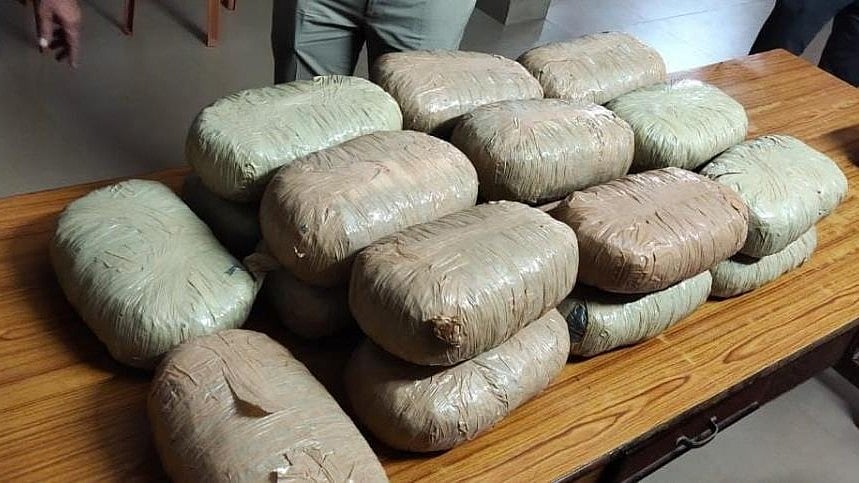
Ganja seized by police. Representational photo.
Credits: DH Photo
Hyderabad: In a shift in the regional narcotics landscape following Thailand’s decision to legalise cannabis, traffickers have turned to smuggling high-potency hydroponic ganja into India often through Hyderabad’s Rajiv Gandhi International Airport (RGIA).
Over the past two financial years, RGIA has emerged as a frontline in India’s efforts to curb the inflow of hydroponic cannabis sourced from Southeast Asia.
With international travel expanding again, customs officials in Hyderabad have been confronting a sharp rise in attempts to smuggle cannabis varieties grown in controlled hydroponic setups, known for being far stronger and more addictive than the locally cultivated marijuana commonly found in India.
According to officials, customs teams at RGIA have seized over 110 kg of hydroponic ganja valued at nearly Rs 110 crore in the illicit market in the last two financial years. The surge in smuggling attempts, they say, is directly linked to Thailand’s decision in 2022 to decriminalise cannabis.
“Since Thailand’s decision to decriminalise the plant in 2022, the country has witnessed a rapid proliferation of dispensaries, cafés and street kiosks selling cannabis products of varying strengths. Lenient regulation and widespread visibility of cannabis in tourist districts have unintentionally created a ready supply chain for criminal networks. Easy procurement, coupled with the prospect of high margins in India’s illicit drug market, have driven organised syndicates to exploit India-bound travellers as couriers,” a senior customs official at RGIA told DH.
Hyderabad’s strong air connectivity with Thailand and its steady flow of first-time leisure travellers have made it an attractive target for such smuggling operations.
Over the past two financial years, customs has arrested 21 people, including two Nepali nationals, linked to these trafficking attempts. Many of those detained were youngsters lured by online recruiters offering free trips, accommodation and modest financial rewards in exchange for carrying what they believed were innocuous consumer goods.
One particular case highlighted the sophistication with which traffickers now operate. Customs officers intercepted a passenger arriving from Bangkok with what appeared to be a brand new water heater.
On closer examination, the appliance was found to have been professionally dismantled and hollowed out to create a hidden compartment. Inside, officers discovered 84 vacuum-sealed packets of hydroponic ganja, each tightly compressed into brick form and layered with multiple plastic wrappings to suppress the characteristic strong odour of high-THC cannabis. The concealment was executed with remarkable precision as the heater’s reassembled structure, weight, thermocol padding and factory-style taping, complete with markings of a reputed brand, gave no indication of tampering.
The passenger later confessed that he had been offered Rs 25,000 and an all-expenses-paid trip to Bangkok by an intermediary for transporting what he was told was a household appliance. Although hydroponically grown ganja emits a distinct odour, traffickers have adapted by layering vacuum seals and compressing the material densely, making it appear unremarkable on standard X-ray scans.
“For customs officers, this combination of smell masking and visual camouflage has made detection increasingly difficult. Interdiction now relies heavily on intelligence-based targeting, behavioural analysis, travel pattern scrutiny and inter-agency coordination,” another senior officer told DH.
Customs officials noted that many seizures at RGIA were triggered not by scanning alerts but by subtle cues observed during passenger profiling such as inconsistent answers during questioning, discrepancies in travel history or mismatches between the stated purpose of travel, their packing patterns and contents of their baggage.